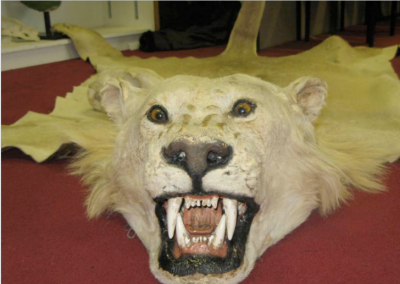News
Latest Lion Aid News
Lion skeletons in the closet?
Tuesday 17th July 2018
|
South African authorities now approve an annual sale of 1,500 lion skeletons from captive lion breeders to Asian buyers.
1. “The 2018 export quota is based on new evidence from a research project established by the South African National Biodiversity Institute (SANBI) in collaboration with the University of the Witwatersrand, Oxford University and the University of Kent that analyses and monitors the lion bone trade in South Africa.”
2. “The captive breeding industry is in a state of flux as breeders respond in different ways to the US’ restrictions on trophies as well as the imposition of the skeleton export quota”.
3. “...approximately 7 000 [captive bred] lion (sic) are kept in around 260 captive breeding facilities in South Africa”.
Condensing this even further, it boils down to this:
1. South African lion breeders are stuck with huge numbers of lions they cannot sell to trophy hunters. To recover some of their costs, the only option is to sell bones and skins and claws and lion fat or whatever has a bit of value. Like not being able to sell a car destroyed in a collision, but still being able to sell parts like the tyres, spark plugs, catalytic converter, scrap metal....
2. Oxford and Kent University "consultants" have gone along with this "fire sale" and it seems signed off on an increased bone quota to keep lion breeders happy? Meanwhile, in statements to the UK public, both institutions "abhor" lion breeding for trophies and other “products”.
3. Edna Molewa (the SA Minister of Environment) does not know what to do with all these captive bred lions. For her, the solution seems to be to sell the remaining lions for bones as last gasp for a failed industry that her department said they would not regulate.
Let’s review a bit of history about the growth of the captive lion breeding industry in South Africa, where private ownership and breeding of lions for whatever profit can be accumulated was tolerated by all authorities.
Lion breeding initially paid big dividends but smacked of a Ponzi scheme. There were no controls or standards as captive bred lions fell in a convenient regulatory gap between the Ministry of Environment (captive bred lions were not wildlife) and the Ministry of Agriculture (lions were not domestic animals).
Soon after the South African government allowed the morally and ethically repugnant business of breeding lions to be trophy hunted and sold for parts, the practice came under international scrutiny. In recent years, the many additionally lucrative aspects of the captive breeding industry, including cub petting, use of paying international “volunteers” to fund breeding facilities, lion “walks” with tourists paying close to $200 per person per hour – also received significant national and international criticism and led to diminished interest in such activities. Trophy hunts of “canned” lions then also came under increasing condemnation. Some hunting associations in the USA and Europe recently advised their members not to participate in captive bred lion hunts. The South African Professional Hunter’s Association initially distanced themselves from the practice of canned hunting, but then recently reversed this opinion.
But perhaps most damaging to the canned hunting industry was a decision made by the US Fish and Wildlife Service to cease import licences for captive bred lion trophies as such hunts did not “enhance” conservation of the species. As US hunters accounted for about 65% of all captive bred lion hunts, the bottom fell out of the market. It should be noted, however, that almost all EU member states (notably the main lion trophy importing countries like Germany, Spain, Denmark) continue to allow imports of captive bred lion hunting trophies as do many other nations like the United Arab Emirates, Mexico, Canada, Russia and China. In addition, there is considerable evidence that South African authorities violate CITES rules by exporting captive bred lion trophies under the “wild” source code, especially to the USA to perhaps attempt to avoid USFWS regulations.
There are currently about 7,000 captive bred lions languishing in about 260 breeding facilities. The operators have few remaining means of earning income from those lions, but fortunately for them the South African government has thrown them a bit of a bone by allowing them to trade skeletons to Asia. And other lion “products” like skins, teeth, claws, etc.
Practitioners of “traditional Asian medicines” seemed to have no qualms about substituting tiger bones for lion bones – while lions never “traditionally” occurred in Asia. |
Add a comment | Posted by Chris Macsween at 20:12




